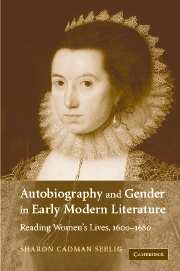Book contents
- Frontmatter
- Contents
- Preface
- Introduction: mapping the territory
- 1 Margaret Hoby: the stewardship of time
- 2 The construction of a life: the diaries of Anne Clifford
- 3 Pygmalion's image: the lives of Lucy Hutchinson
- 4 Ann Fanshawe: private historian
- 5 Romance and respectability: the autobiography of Anne Halkett
- 6 Margaret Cavendish: shy person to Blazing Empress
- Conclusion: “The Life of Me”
- Notes
- Bibliography
- Index
Introduction: mapping the territory
Published online by Cambridge University Press: 22 September 2009
- Frontmatter
- Contents
- Preface
- Introduction: mapping the territory
- 1 Margaret Hoby: the stewardship of time
- 2 The construction of a life: the diaries of Anne Clifford
- 3 Pygmalion's image: the lives of Lucy Hutchinson
- 4 Ann Fanshawe: private historian
- 5 Romance and respectability: the autobiography of Anne Halkett
- 6 Margaret Cavendish: shy person to Blazing Empress
- Conclusion: “The Life of Me”
- Notes
- Bibliography
- Index
Summary
The question posed by Margaret Cavendish at the end of A True Relation, “Why hath this lady writ her own life?”, has proved provocative enough to stay with us over the centuries and even to inspire a number of recent titles. Why indeed hath this lady writ her own life? Quite often, of course, she did not, preferring instead to write someone else's life – most frequently her husband's – and to define her role within their mutual destiny; often, early modern women wrote no life at all. But despite Virginia Woolf's famous assertion that there were almost no women writers in this period (because “any woman born with a great gift in the sixteenth century would certainly have gone crazed, shot herself, or ended her days in some lonely cottage outside the village, half witch, half wizard, feared and mocked at”), a remarkable number of women did record aspects of their lives in diary, autobiography, poetry, confession, or tract. In the case of Cavendish, as I shall argue, the writing of her life seems to have been an act of self-preservation of the most elemental and perhaps desperate kind. And Anne Clifford, who began compiling a family history to establish her place among her distinguished ancestors and to justify her inheritance, continued keeping records until the day she died.
- Type
- Chapter
- Information
- Autobiography and Gender in Early Modern LiteratureReading Women's Lives, 1600–1680, pp. 1 - 14Publisher: Cambridge University PressPrint publication year: 2006

